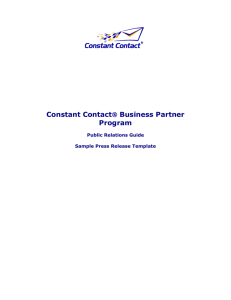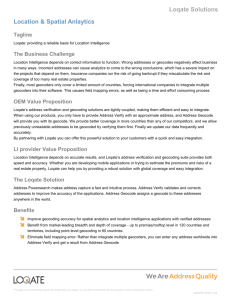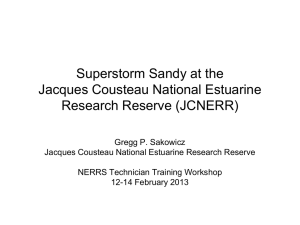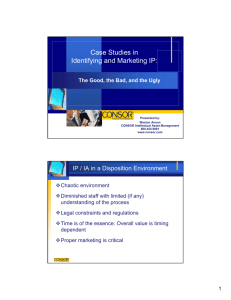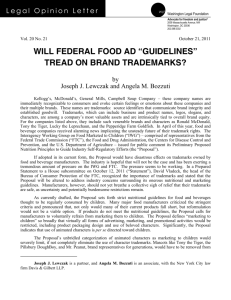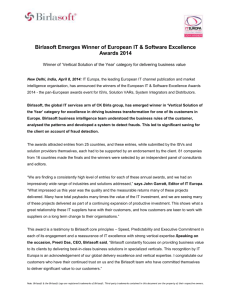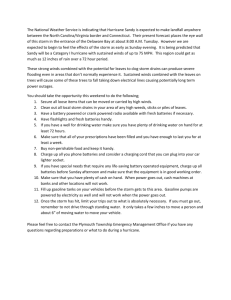Improving Risk Management Modeling with Address
advertisement
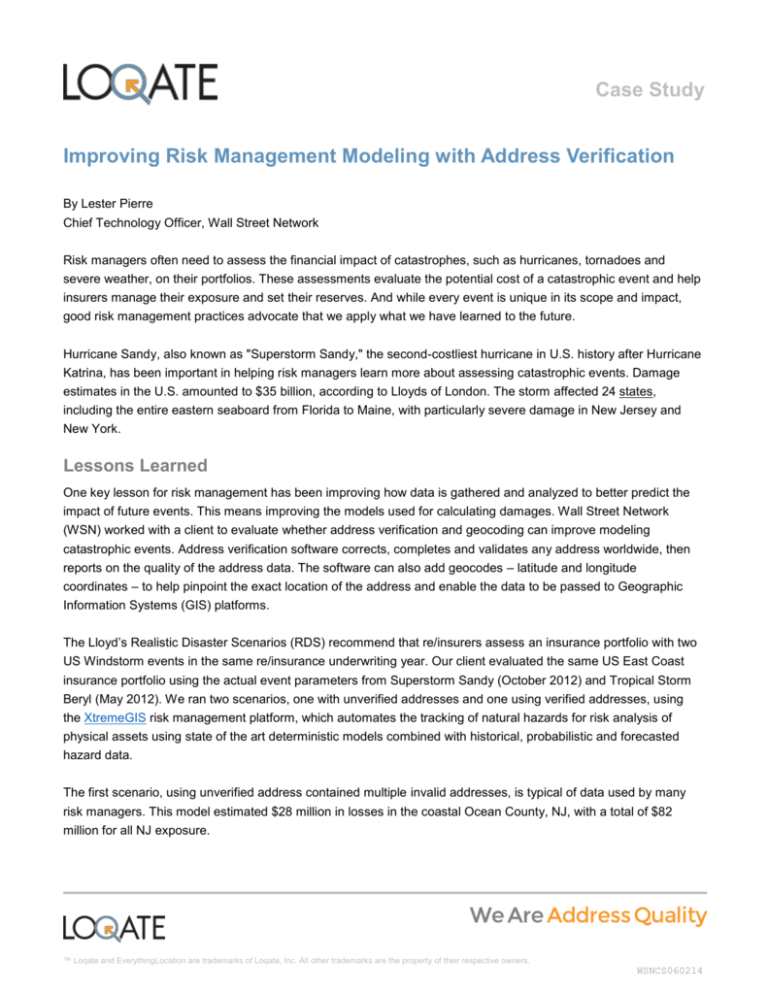
Case Study Improving Risk Management Modeling with Address Verification By Lester Pierre Chief Technology Officer, Wall Street Network Risk managers often need to assess the financial impact of catastrophes, such as hurricanes, tornadoes and severe weather, on their portfolios. These assessments evaluate the potential cost of a catastrophic event and help insurers manage their exposure and set their reserves. And while every event is unique in its scope and impact, good risk management practices advocate that we apply what we have learned to the future. Hurricane Sandy, also known as "Superstorm Sandy," the second-costliest hurricane in U.S. history after Hurricane Katrina, has been important in helping risk managers learn more about assessing catastrophic events. Damage estimates in the U.S. amounted to $35 billion, according to Lloyds of London. The storm affected 24 states, including the entire eastern seaboard from Florida to Maine, with particularly severe damage in New Jersey and New York. Lessons Learned One key lesson for risk management has been improving how data is gathered and analyzed to better predict the impact of future events. This means improving the models used for calculating damages. Wall Street Network (WSN) worked with a client to evaluate whether address verification and geocoding can improve modeling catastrophic events. Address verification software corrects, completes and validates any address worldwide, then reports on the quality of the address data. The software can also add geocodes – latitude and longitude coordinates – to help pinpoint the exact location of the address and enable the data to be passed to Geographic Information Systems (GIS) platforms. The Lloyd’s Realistic Disaster Scenarios (RDS) recommend that re/insurers assess an insurance portfolio with two US Windstorm events in the same re/insurance underwriting year. Our client evaluated the same US East Coast insurance portfolio using the actual event parameters from Superstorm Sandy (October 2012) and Tropical Storm Beryl (May 2012). We ran two scenarios, one with unverified addresses and one using verified addresses, using the XtremeGIS risk management platform, which automates the tracking of natural hazards for risk analysis of physical assets using state of the art deterministic models combined with historical, probabilistic and forecasted hazard data. The first scenario, using unverified address contained multiple invalid addresses, is typical of data used by many risk managers. This model estimated $28 million in losses in the coastal Ocean County, NJ, with a total of $82 million for all NJ exposure. ™ Loqate and EverythingLocation are trademarks of Loqate, Inc. All other trademarks are the property of their respective owners. WSNCS060214 In the second scenario, the address data was verified and geocoded using Loqate’s Verify and Geocode software integrated into the XtremeGIS platform. We wanted to demonstrate the impact of address verification on the calculation of loss estimates. The event was reprocessed in the XtremeGIS platform using the same hazard event parameters. XtremeGIS could now leverage the use of correctly positioned data for accurate coastal and underlying hazard proximity such as storm surge and wind speeds. Using data from Loqate’s Data Quality Report (DQR), XtremeGIS was able to showcase a map that visualized the concentration of corrections and enabled us to easily identify clusters of bad data sources. Assessment Changes by Millions of Dollars The difference between the two scenarios was surprising. In the second scenario that used verified and geocoded addresses, loss estimates for the NJ exposure increased to $90 million, which is $8 million more than the unverified address model. Meanwhile, losses for Ocean County, NJ, went down by $5 million to $23 million, resulting in an 18% decrease. What caused such different results? Under the first scenario, the geocoding process did not correctly place insured locations because the addresses were unverified. When an address is not accurate, geocoders make assumptions about the address information. The geocoder will use the “reliable” portion of the address to derive the geocoordinates. As a result, street, zip code or other administrative boundary levels would be used to derive the geocoordinates, not the exact address. These inexact geo-coordinates can severely alter the perception of what underlying hazards exist that would contribute to property damage and insurance loss in the event of a catastrophe. In the second scenario, we started our assessment with verified and geocoded address data. As visualized in the DQR, the accuracy of the results improved dramatically. We were able to identify exact address locations by verifying, correcting and geocoding the addresses. This comparison clearly illustrates how poor address data can lead to inaccurate loss estimates. In Ocean County, NJ, we were able to see that the actual location of many properties were farther away from the ocean than previously shown, so loss estimates decreased. Total loss estimates for the NJ exposure went up as the verified address data showed that the aggregate damages in other counties increased by $13 million. While there are many factors to consider for improving risk management decisions, address verification and geocoding is a simple entry point for any data quality initiative. The result will be a more accurate assessment of the underlying hazards that impact financial and risk management decisions. Lester Pierre is a dynamic visionary technology executive. He serves as the CEO, CTO and Co-founder of Wall Street Network (WSN) and has over 26 years of business, technology and software engineering experience in the insurance, banking, finance, retail and manufacturing industries. ™ Loqate and EverythingLocation are trademarks of Loqate, Inc. All other trademarks are the property of their respective owners. WSNCS060214 Figure 1 Deterministic Modeling of Lloyd’s RDS using Tropical Storm Beryl 2012 & Superstorm Sandy 2012 ™ Loqate and EverythingLocation are trademarks of Loqate, Inc. All other trademarks are the property of their respective owners. WSNCS060214 Figure 2 Superstorm Sandy Track & Storm Surge ™ Loqate and EverythingLocation are trademarks of Loqate, Inc. All other trademarks are the property of their respective owners. WSNCS060214 Figure 3 Ocean County, NJ – Exposure with Storm Surge & Maximum Sustained Wind Hazard More Information Loqate: www.loqate.com Loqate, Inc | 999 Baker Way Ste 320 | San Mateo CA 94404-1566 USA | +1 (650) 273-5603 | info@loqate.com Wall Street Network: www.wsn.net Wall Street Network | 44 Wall Street | New York, NY 10005 USA | +1 (212) 635-0100 | sales@wsn.net ™ Loqate and EverythingLocation are trademarks of Loqate, Inc. All other trademarks are the property of their respective owners. WSNCS060214
